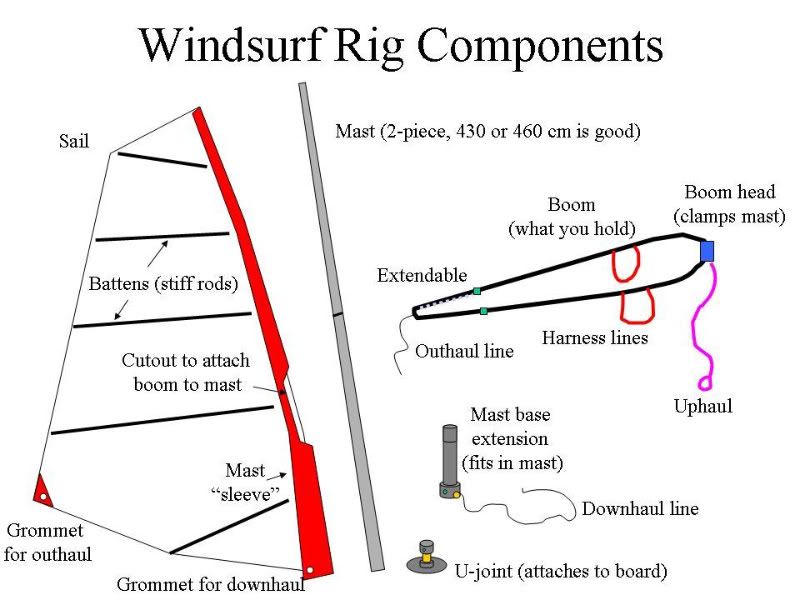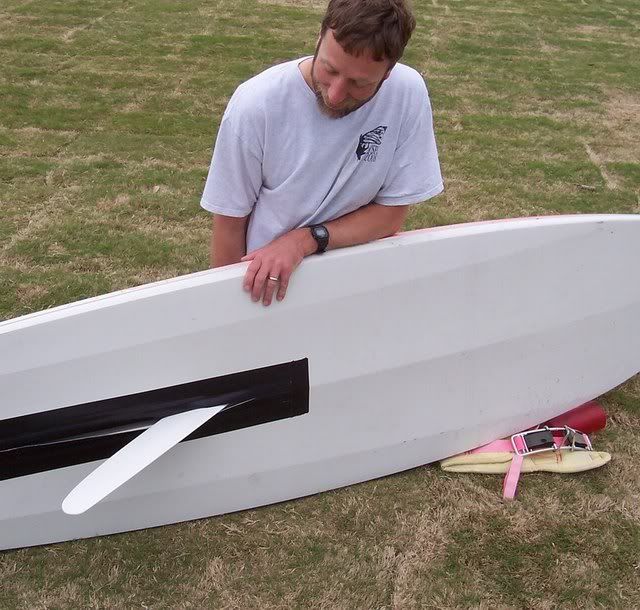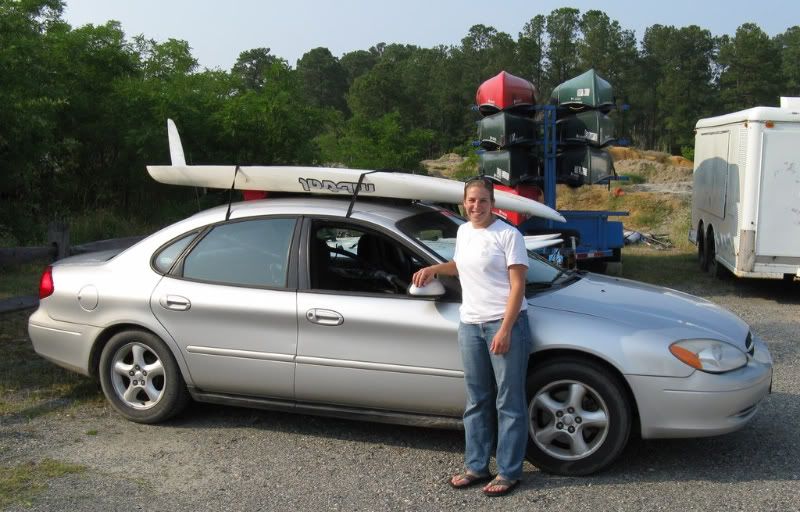James’ Guide to Windsurfing on the Cheap
1. ANY windsurfing is better than NO windsurfing. Don’t let the fact that you can’t afford new gear stop you from getting on the water somehow.
2. Get ready to do some experimenting and “tinkering” with your gear. Basically you are going to put together the windsurfing equivalent of Frankenstein’s monster, using used gear that no one else wanted. This will be an instructive and rewarding process. At the end you will have a better understanding of the equipment side of the sport than someone who gets everything new and complete from the store.

3. Secondhand gear is your friend. There are several ways to get it...
*Commandeer it from your aging or disinterested friends and relatives. There is a lot of perfectly functional windsurf gear collecting dust in people’s garages. More often than not, they’re happy to let it go for cheap or free.
*Get in the loop, locally. If you talk to and hang out with the windsurfers in your area, and join your local club if it exists, you will be the first to hear about good deals on used stuff. If you are a friendly, fun person who people want to sail with, they will often bend over backwards to help set you up with gear. Just be aware that serious windsurfers have sometimes forgotten what it’s like to be a poor newbie, and they may make snobby gear recommendations that are unrealistic for you and your situation.
*Scrounge at the shop. Unlike online dealers, real life windsurf shops often have lots of cheap, used gear. They may also host swap-meets at the beginning and end of the season, which can be a bonanza for savvy shoppers.
*Get in the loop, online. Sites like iwindsurf have a classifieds ads section, and gear for sale will also often appear on regional windsurfing bulletin boards and email lists. If you shop for windsurfing gear on Craig's list or Ebay it can be helpful to ask in the iwindsurf forum if something is a good deal before you buy it, but be prepared for lots of differences of opinion.
4. Figure out what you need. It’s useful to take a bottom-up approach and make a list of the ingredients required to assemble a working windsurf. You can base it on this diagram and list.
A board with plenty of volume for flotation. Consult my windsurfing gear calculator if you’re unsure about what volume you need. A longboard (a large board with a daggerboard as well as a fin) is an ideal cheapskate’s board because it is usable in all wind conditions, is easy to progress on, and isn’t overly sensitive to the particular sizes of sails and fins that you use. As a beginner windsurfer you should generally avoid shortboards (those with no daggerboard), because they require more advanced skills, stronger wind, and specific sails and fins. If you do get a shortboard, prepare for a frustrating learning experience with lots of waiting for wind and struggling to get going.

A universal joint that is compatible with the mast-track in your board. If you have an old longboard, it may have an odd mast track. Old, Mistral brand adjustable mast tracks often had an extra, threaded hole, making them compatible with modern single-bolt u-joints. Other mast tracks can sometimes be converted to a single-bolt system, although they may no longer be adjustable after the conversion. Ask at your local windsurf shop for help with this.
A mast-base extension that is compatible with your universal joint, has enough extension range to suit your mast and sail, and has robust pulleys and cleats for downhauling the sail. Buying a new aluminum mast-base extension and universal joint is usually a good investment even if your funds are scarce, because they are such a key part of your rig.
A mast that will fit the size and type of sail that you will use most often. Old fiberglass masts work ok with pre-1995 sails, but may be too fat at the tip to work in more modern sails. Newer masts (grey or black ones with carbon in them) work in both new and old sails and are lighter. A 460 cm mast is a good size for an average sized man, because it will work in sails from about 7.5 m2 (if it’s a new sail) to 5.5 m2 (if it’s an old sail). For a small guy or an average sized woman, a 430 cm mast is a good size, because it will work in sails from about 6.5 m2 (if it’s a new sail) to 4.5 m2 (if it’s an old sail).
A sail. Your bread and butter sail should be one that will get you planing on a good day. Later on you can add a larger sail for planing on marginal days, and a smaller sail for exceptionally windy days. In most areas, a “good day” means about 15 knots. So you can use 15 knots and the weight-appropriate sail indicated by the sail calculator to figure out what size sail to look for. If you are still working on the most basic skills like uphauling and tacking, then you may want to get a somewhat smaller sail.
A boom. You should get a clamp-on boom with a secure-feeling connection to the mast. It should have a large, robust clamp with a metal (not plastic) cleat in it. The size of the boom is dictated by the size of the sail. Your boom should be able to fit your bread and butter sail with a moderate amount of extension, leaving room for a larger or smaller sail if you add one later. A boom size range of about 170 – 220 cm is good to start with.
5. Develop a discriminating eye for gear and a sense of how much it’s worth.
*Some stuff isn’t worth the trouble, even if it’s free. In this category are: 1) Fiberglass masts that look “fuzzy” on the outside where the itchy glass fibers are exposed. 2) Boards with grievous damage, or missing, non-standard components that you don’t have the time or skill to deal with. 3) Tie-on booms, one-piece masts, and simple, triangular sails (unless they come as part of a complete, antique rig in excellent condition). 4) Colored plastic downhaul tools, which will split in your hand and cut it open.
*Some stuff is better than nothing, but may have compatibility and performance issues. Pretty much anything from the early 1990s or earlier falls into this category, and you shouldn’t pay more than a few tens of dollars for it, at most. Sails from this era can be recognized by being made largely of laminated cloth with bold colors. Boards from this era often had heavy plastic construction and rear footstraps on the centerline of the board. There were also a lot of longboards from this time that had daggerboards, but were stingy with width and volume, and thus were almost as hard to ride as shortboards, especially for full-sized dudes. These boards had anywhere from 140 – 180 liters volume and were about 300 – 340 cm in length.
6. Learn how to make minor repairs and improvisations.
*The most common windsurfing repair is taping over small tears in the clear plastic part of monofilm sails. As long as a rip isn’t too big, and doesn’t go all the way to a cloth seam on the sail, you can carefully clean and dry the area around it and put tape over it on both sides to fix it. The best type of tape to use is specialized clear sail tape that you buy at the windsurf shop. If you can’t afford that, regular packing tape works ok, and black “Gorilla Tape” works great if you don’t mind the looks. Grey duct tape degrades in the sun and isn’t so good.
*Dings in a board can be repaired with a stick of “plumber’s epoxy”, which is sometimes marketed at windsurf shops as a “ding stick”. It’s the same thing as plumber’s epoxy, just more expensive. It’s a clay-like substance that hardens in about an hour. If you make a lot of repairs with it, it will look like your board is covered with wads of chewed gum. If you don’t like the looks, you can sand the wads flat and paint over them.
*Regular epoxy can also be used for some repairs. There’s a whole art to board repair that I won’t get into here. If you want to learn more, check out the instructions on the Windance Website or visit the “Board Lady” Eva-M Hollmann.
*Lots of times old longboards are in perfect shape except for a rotted or torn daggerboard gasket. You can sail them without fixing the gasket, but they will be slower and water may shoot up through the opening. Your local windsurfing shop might be able to help you order a new gasket, or you try to find one online, or you could make your own. The cheapest way to make your own is with Gorilla tape. Lay two pieces out sticky side up, parallel, and overlapping slightly. Then lay one piece sticky side down over the seam between the other two pieces. Stick the tape down over the daggerboard slot and voila – instant gasket, quality not guaranteed.

7. Make your car work for you; don’t work for you car.
*If you are poor, the last thing you need is a new car with big monthly payments. Go for a cheap car, since it’s going to be messed up anyway by your nasty windsurfing gear. Station wagons are nice since they can easily accommodate roof racks on top and sails, booms, and masts inside. Your car can also double as your permanent windsurfing gear storage area. Since you’re sailing old, ugly gear, it’s ok to leave it outside on your car all the time, unless you live in a particularly desperate, high crime area.
*Roof racks can be expensive, but if you’re lucky, you can find some for your model of car on eBay or Craig’s List. If you’re handy, you can make your own. In a pinch, you can even strap a board to your roof without any racks. Just roll up some towels as pads, put the board upside down on top of them, and run straps through the tops of the doorways in the car (see picture). You’ll be fine unless it rains hard.

*For straps, it’s worth the investment in real surf straps. Straps with hooks or bulky ratchets, the type you are most likely to find at the hardware store, are meant for boat trailers and pickup beds, and are inconvenient for regular roof racks. Make sure the straps you get are long enough but not too long.
8. Make windsurfing number one.
You may think windsurfing is expensive now, while you are first starting. However, as you get more addicted you will find that windsurfing becomes more fun than almost everything else in your life, and it will seem perfectly natural to spend a large portion of your income on it. You will have no qualms about economizing in other areas to maximize your windsurfing. For instance, you can probably cancel your cable, sell your video game console system, cut down on your drinking, moderate the air conditioning, etc. If you are a single man you can decide to only go out with modern, liberated women who don’t mind going Dutch on dates. If you are a single woman, you can decide to only go out with traditional gentlemen who pay for everything. You’ll figure it out.

19 comments:
Hey,
This is a great post. My first complete rig cost me around $70. I was lucky and had many friends with disposable gear but another resource (which you sort of alluded to) is the local windsurfing newsgroup (I was in Seattle and posted on NW-Windtalker). I found people so happy to get some fresh blood out on the water, they were giving me their gear for free or only asking me to pay for the gas needed for them to pick up their gear in Hood River. And yes, now that I am gainfully employed and thoroughly addicted, I spend more on gear-- especially on those windless days in the Gorge.
Funny. I'm one of those modern, liberated women I suppose so I just choose not to date. But I'll give your suggestion some thought.
Sophia
James,
I was thinking of writing something similar to this. What a great post! This is exactly how I got started. It began with hand-me-downs from the local group of windsurfers, then I got lucky and scored a 1985 F2 from a friend of my father-in-law. A few months later I bit the bullet and bought a new board, and it wasn't the right one. My buddies pushed me towards a wideboard with no daggerboard (Starboard Go 165). It was fine for certain conditions, but not ideal. A beginner's board *must* have a daggerboard.
Oh, and were you responding to Matt Pritchard's column too?
-Ian
This is exactly how I started. 165 bucks for a early 90's complete longboard setup. Sold it a couple years ago for $100. To pass along the stoke.
There is one point that you failed to mention and that is the all important lesson. I don't care how poor you are that is the best money you will ever spend, hands down. $25, $75 It is a cheap insurance to get ahead of the frustration curve and possibly keep one from ending up in a potentially bad situation.
Chris
James, great post. I had one of those fuzzy masts when I started and it drove me up the wall!
The line I draw is cutting down on drinking. That's just out of the question. Maybe I can drink high-life instead of nut-berry crunch microbrews?
Aaron- PBR is a good option, too.
James,
Couldn't agree with you more - there's no reason you can't get a stoke and preserve your IRA account...I recently purchased three 'new' sails for a grand total of $350 ( a 5.7, 90. and 11 meter!) - the oldest was four years old. I plan on sailing these for at least 10 years before I purchase another 'new' sail - recycle and shred...
Milo
Right on, Milo. :)
Absolute great article.
Can emphasize enough that any if better than none.
Here's a Tube of some of my sailing... on a $25 board found at a yard sale (dealt down from $100). Got 2-3 years' use out of it, in 5-20 knots.
I still find old sailable Windsurfers, about one a year. Best free site I find is Kijiji, followed by Craigslist.
http://www.youtube.com/watch?v=z2pnL0U9C4A
Well done again !
I LOVE THIS SITE!
OF COURSE your local windsurfing instructor will want YOU to buy new stuff and make him/her more money in the process. NOT to dispel the fact that newer gear is much better...it is. BUT if you are poor like I am poor there IS still great fun to be had on older gear. I went to 'the hook' in the Columbia Gorge last year having never WS before and within two hours(no instruction but my intense attention to youtube videos!)I was able to go where I wanted...even upwind! with an old 11' Bic and a mid 90's 5.0 ezzy sail. James is right...you will have to do a lot of messing around as it can easily go the OTHER way if you do not match the right sail/board/wind. I went out last weekend on the same board but with a smaller sail in higher wind and I got my a** handed to me...it was a nightmare. Still fun to be in the water(and I spent PLENTY of time there!!!). Obviously, instruction and lotsa money will save you any hassles that are not realted to JUST learning what is best ON what is best. But MOST of us(???)are 'poor' or just not going to WS enough to warrant the HUGE expense of new or even recent gear. If you are(as I am)more about having fun than living in a tent and eating Beefaroni so you can afford recent or new WS gear, then you have the recipe that works for me(and James!)and many others. Like he said: ANY windsurfing is better than NO windsurfing! In fact you can say just that whenever you meet with the 'you should get/do' attitudes. it will shut them down because even THEY know it is true. Besides...if you wanna get REAL picky...we would all windsurf more(even your egofied WS friend)if we had HELICOPTERS to get us to the sites! Some do! So you will always come up short relative to those who need money to have fun. Congratulate yourself that YOU are brave enough to squeeze fun out of less bucks. It's windsurfing...not hang gliding! if you fall, you hit the nice water...just get up and try again!
Thanks for your blog ! I got myself an old Dufour and and old Bic Windsurfer. I've had a great time Stand-up-paddling them. They actually offer better SUP performace that my new 10'8 cuiser. I did not dare yet try to rig those old sails for my second trip on a windsurf board. They seem heavy to carry if I have to swim my gear upwind. I was thinking of getting a newer smaller/lighter rig to go on them to make it easier for me to start... and take a paddle along...Those would be lighter if I have to paddle upwind.
Hi Andie,
Good to hear you had success using the old Dufour and Bic as SUP boards!
A small, light rig will definitely make your first steps into windsurfing easier. :)
-JGD
hello and HELP I did not read this post before buying a board and am regretting it. MAY have made a big mistake but trying to remember that this poor persons memories sparked a need to offer a chance to surf the wind, to my teens. A Klepper 350 with all the no no's...single mast, plastic boom clamp with a tye on set up that I can't remember how to use. Anyone able to help me....I believe the seller that did use it twice last year but ex boyfriend did the rigging. Maybe that was a cue to NOT buy it...should of stuck to kayaking. help
Annette in BC, Canada
Roughly a year ago I realized I wanted to take up windsurfing. I took lessons, and I did the basics. But, and as recently as last weekend, I found myself wondering, as I drifted sideways in a light breeze only to have the sail ripped from my hands by a gust, just how the thing actually worked. Then, I found out that the sail isn't pushed by the wind, but rather that it actually flies and creates lift!! (a friend, and www.na-windsurfing.com). Also, I learned about the sail's green zone, and stalling, and how induced wind is the essential component in sail positioning in order to move ahead "efficiently" (after actual wind). Fundamental, simple, amazing, and beautiful; and, a necessary understanding in order to become a sailor.
Anyone know if I can convert a 2012 BIC SUP into a windsurfing board. BIC has a combo model, but I got a good deal on the SUP model and I'm hoping I can get a few windsurf parts and make it work. Any recommendations are welcome, at georgea0731@gmail.com.
thanks in advance and best wishes,
George,
You can add a mast track to the board.
http://www.chinooksailing.com/products/product_info.php?cPath=64&products_id=163
You'll need a router to dig out a spot in the deck of the board, and some high density foam to lay in around the mastbox for more stability. Then liberal amounts of West Systems epoxy and glass cloth to to cement the box in and layer over it. Probably easiest to just buy the mastbox and then have them do it for you at a surf shop.
If you want you can also add a finbox in the daggerboard position to give more upwind sailing ability in non-planing conditions. I did that with a SUP that came with a mast track but not a daggerboard. Same type of installation as for a mast box.
Good luck.
-James
I once was (and may still) going to do this on an SUP, but the Board Lady said the interior construction of the board is important. So in other words not all boards can be modified? There is a lot of force on a sail.
Hi and thank you james i got all my things for free as it come off free sites or gumtree i just got to get the wife to let me go out and ues it
Great article! I started "windsurfing" after high school; I was given a small used flat-topped sailboat (I forget the brand) for graduation and I would stand up on it. Then I bought a brand new package (plastic board) in the 80's for just $325. I gave away my next set of gear (FreeCycle) about 8 years ago because it was gathering dust. Saved a couple sails, though. Now am wishing I saved it! After bailing on kiting (scary dangerous), I miss my fun windsurfing! The search is on! Anyone in the VT/NH/Western Mass area have decent gear they want to pass along free or cheap? Thanks! Deb
Post a Comment